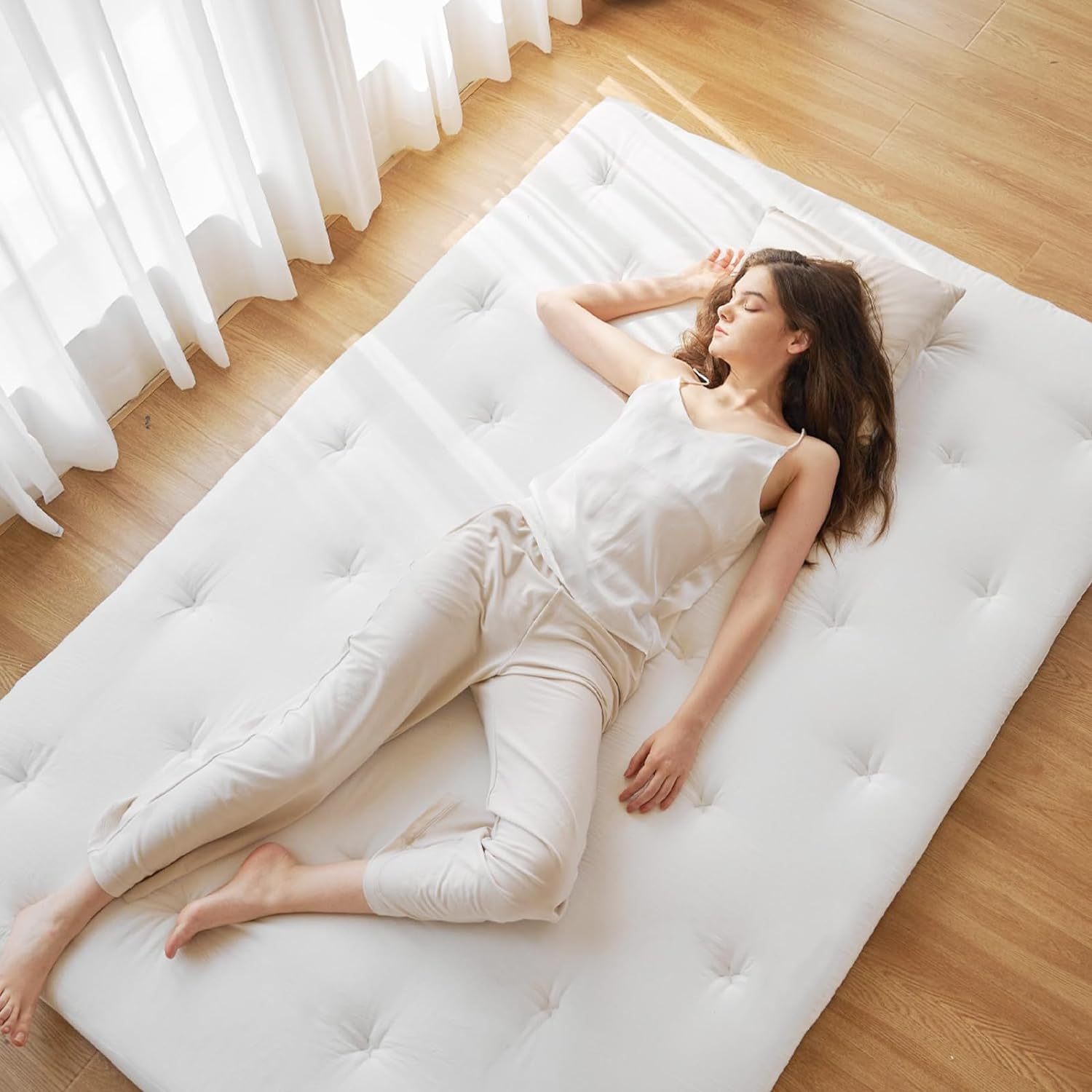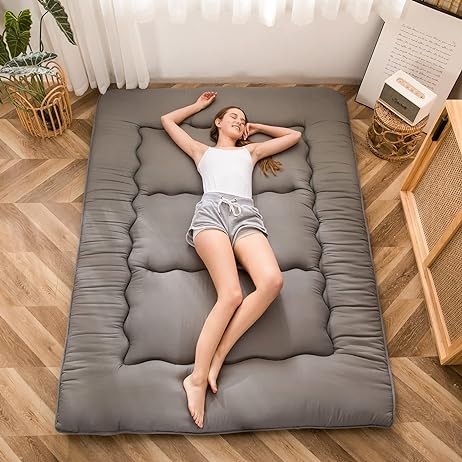Is Sleeping On the Floor Good for Your Back? Exploring the Health Benefits
Ever wondered if sleeping on the floor could help your back problems or ruin your sleep entirely? Some people swear by this practice, saying it reduces back pain and improves posture. While there are potential benefits to floor sleeping, it’s not a one-size-fits-all solution.
Sleeping on the floor can feel quite different from the comfort of a mattress. The hard surface may help some people achieve a neutral spine alignment, leading to less back pain. However, not everyone finds the floor suitable, and you could experience discomfort or worsen existing conditions.
It’s important to consider health factors and individual comfort when thinking about making the switch. Testing it out with a nap or short trial period could be a good way to see if floor sleeping works for you.
Key Takeaways
- Floor sleeping may help with neutral spine alignment.
- It isn’t suitable for everyone and may cause discomfort.
- Trying it out first can help you decide if it’s a good fit for you.
- Some suggest floor sleeping has benefits, but opting for a firmer mattress may be worth considering.
- During winter, a cold floor can quickly lower your body heat, causing you to feel colder than normal.
- During the hot summer months a little extra coolness sleeping on the floor isn’t disagreeable.
Exploring the Basics of Sleeping on the Floor
Sleeping on the floor can feel quite different compared to using a traditional mattress. It has its own set of benefits and challenges that you should know about.
What Is Floor Sleeping?
Floor sleeping means you lie directly on the floor, sometimes with a thin mat or blanket as your only padding. This approach is often seen as a way to align your spine better. People from cultures that practice floor sleeping say it’s good for your posture and can ease some forms of back pain.
Floor sleeping is often chosen to counter the soft nature of traditional mattresses, which can cause your spine to curve. By contrast, a hard surface keeps your spine in a more natural position. Some people use a thin mat to add a bit of comfort while still getting the benefits of a firm surface.
Comparing Floor Sleeping to a Traditional Mattress
When you sleep on a traditional mattress, you usually have a lot of cushioning. Soft mattresses can feel cozy but might not offer enough support. Your body may sink into the mattress, which can misalign your spine and cause back pain over time.
Using a firm mattress can help, but it still isn’t the same as the floor. Sleeping on the floor gives an even firmer surface which some people find helpful for maintaining a straight posture during sleep. This can potentially reduce back and neck pain by keeping your spine in a neutral position throughout the night.
Floor sleeping can feel strange at first. It might take several days or even weeks to get used to it. You can experiment by taking naps on the floor before fully committing to this method of sleep. It’s also important to consider your own physical conditions, as floor sleeping might be uncomfortable or even harmful for some, like those with certain health issues.
Potential Benefits of Sleeping on the Floor
Sleeping on the floor can potentially offer several benefits, including improving spinal alignment, reducing back pain, and enhancing sleep quality. This section explores these potential advantages in detail.
Improving Spinal Alignment
One potential benefit of sleeping on the floor is that it may help with improving spinal alignment. The firm surface provides more consistent support compared to a soft mattress. When you sleep on the floor, it can help keep your spine in a more neutral position.
Without the sinking sensation caused by a soft mattress, your body is likely to maintain better posture throughout the night. Better spinal alignment can help to reduce the risk of developing back issues over time. Some people find that a firmer surface helps avoid unnecessary bends and curves in the spine.
Maintaining a neutral spine can also be beneficial for your overall posture and physical health during the day. It may take some time to get used to sleeping on the floor, so try different positions to see what works best for you.
Reducing Back Pain
Many individuals report that sleeping on the floor helps reduce back pain. A firmer surface can provide more solid support to your body, preventing the misalignment that can often occur with softer mattresses. This is crucial for people who experience low back pain and are seeking alternative solutions.
A firm foundation can distribute your body weight more evenly and reduce pressure points. By keeping your spine aligned and supported, it helps minimize the chances of waking up with stiffness or aches. Be sure to use a thin pillow or no pillow at all to keep your neck aligned with your spine.
If you have chronic pain, it’s essential to consult with a healthcare provider before making significant changes to your sleep habits. Nevertheless, many find that floor sleeping offers the firmness needed to support their back properly.
Enhancing Sleep Quality
Some people believe that sleeping on a firm surface like the floor can improve overall sleep quality. Without the dips and sags of a mattress, you might experience less tossing and turning throughout the night. This can result in a deeper, more restful sleep.
A firm surface can also make you more aware of your sleeping position, encouraging you to maintain better posture even while you sleep. Improved posture can lead to fewer disturbances and a more uninterrupted sleep cycle, helping you wake up feeling more refreshed.
It’s important to experiment with different setups, such as using a thin mat or just sleeping directly on the floor. Pay attention to how your body feels and make adjustments as needed to find what enhances your sleep quality the most.
Health Considerations and Conditions
When thinking about sleeping on the floor, it’s important to consider your health conditions and how different sleeping positions and body types may be affected. This can help you decide if this method is right for you.
Impact on Chronic Conditions
Sleeping on the floor can affect various health conditions. For instance, people with arthritis might find it challenging because hard surfaces may increase joint pain. On the other hand, some believe that firm surfaces can help with conditions like sciatica by providing better spinal alignment.
If you have anemia, diabetes, or hypothyroidism, you may feel colder at night. Since the floor is cooler, it could worsen these issues. Pregnant women and older adults should be cautious. The floor can be hard to get up from, potentially leading to mobility issues. Additionally, being close to dust and cold can make blood circulation problems worse for seniors.
Sleeping Positions and Body Types
Your preferred sleep position and body type play a big role in how comfortable you’ll be on the floor. Back sleepers might benefit from the firm support from a flat surface, as it can help keep the spine aligned. However, side sleepers could experience more pressure points on a harder surface, leading to discomfort in hips and shoulders. For stomach sleepers, the firmness of the floor might cause neck strain because of the lack of cushion.
Different body types also react differently. People with more body mass may feel cushioned enough on the floor, while slim individuals might find it too hard. If you suffer from joint pain or have mobility issues, getting up and down from the floor could add more stress to your body.
Considering these factors can help you decide if sleeping on the floor is the right choice for you.
Addressing Comfort and Support

When you decide to sleep on the floor, it’s important to consider both comfort and proper support to avoid any discomfort or pain.
Choosing the Right Cushioning
A hard floor can be tough on your body, putting pressure on various points. To ease this, you might want something soft, like a cushioned mattress pad or a futon. These can provide the right mix of firmness and softness.
If you’re looking for a firmer surface but still want some comfort, you can use a piece of plywood covered with a layer of cushioning. This setup can help in maintaining a good posture while you sleep. Experiment with different types and thicknesses to find what works best for you.
For those new to floor sleeping, start with a thicker cushion and gradually switch to a thinner one if it feels better. This gradual approach can help your body get used to the change without too much strain.
The Role of Pillows and Blankets
Pillows and blankets aren’t just for warmth and head support; they play a big role in overall sleep comfort. A good pillow can keep your neck aligned with your spine, which is crucial for avoiding neck pain. Try a firm pillow or a small, folded towel for neck support.
For your body, using extra blankets under you can add cushioning. This is especially helpful for side sleepers who need more support at the hips and shoulders. If you’re sleeping on your back, a pillow under your knees can help keep your spine neutral and reduce lower back strain.
Remember, these adjustments can make a big difference in how you feel when you wake up. Fine-tuning your setup with the right support and cushioning can transform your floor sleeping experience.
Practicalities and Precautions of Floor Sleeping
If you’re thinking about sleeping on the floor, it’s important to know how to manage temperature, keep things clean, and stay safe.
Managing Temperature and Heat
When you sleep on the floor, you might notice that the temperature feels different than on your bed. Because heat rises, floors can be colder. It’s important to use layers of blankets or a sleeping mat to stay warm. This is especially true if you live in a place with cooler temperatures.
On the flip side, sleeping on the floor can help you stay cool during hot weather. You can place a fan nearby to help with temperature regulation. Be mindful of drafts coming from windows or doors, as these can make you feel colder at night.
Hygiene and Maintenance
Keeping your sleeping area clean is crucial. Floors can gather dust, mold, and clutter, all of which can affect your sleep quality. Make sure to vacuum and mop the area regularly to reduce dust mites and other allergens. If you sleep on a carpet, consider using a washable mat or cover.
To prevent mold and mildew, ensure good ventilation in your sleeping area. If you have pets, keep their sleeping areas separate to minimize extra fur and dander on the floor. Regular washing of your bedding is also key to maintaining hygiene.
Safety Considerations
Safety is another important aspect. If you co-sleep with a partner or pets, make sure there’s enough space to avoid accidental falls. Consider using a soft mat or thick blanket to cushion the floor. This can help reduce the risk of injuries if you toss and turn during the night.
For people with conditions like anemia or diabetes, floor sleeping might pose additional challenges, such as staying warm. Take extra care to address these health needs. Be aware of the various types of flooring as well; hardwood might feel colder than carpet, and this can influence your comfort.
These precautions can help you make floor sleeping a safe and pleasant experience.
Lifestyle and Environmental Factors
Your lifestyle and surroundings can play a big role in how well you adapt to sleeping on the floor. From minimalist living to cultural traditions, these factors influence the way we approach sleep.
Minimalism and Sleep Environment
Minimalism often leads people to consider sleeping on the floor as a simpler alternative to a traditional bed frame and mattress. If you have a minimalist lifestyle, you might find that removing unnecessary furniture creates a cleaner, more zen-like space.
Using a tatami mat, a traditional Japanese floor mat, can offer some cushioning while keeping a low profile.
Additionally, floor sleeping can help reduce clutter in your bedroom and create a sense of spaciousness. Specialists in sleep medicine suggest that a tidy sleep environment can improve overall sleep quality. While it may feel different at first, your body can adapt to this new setup over time.
Cultural Practices and Furnishing Trends
In various cultures, sleeping on the floor is a common practice that has been around for centuries. For example, in Japan, using tatami mats and futons is a long-standing tradition that many people still follow today. This practice aligns with other cultural values such as simplicity and nature-connected living.
In contrast, Western lifestyles typically favor traditional mattresses and bed frames. However, recent trends show a growing interest in floor sleeping as people seek to improve posture and decrease back pain. Studies from reputable institutions like Harvard Medical School suggest that cultural furniture choices can directly impact spinal health and comfort.
Understanding these cultural preferences can help you make an informed decision about whether floor sleeping is right for you. Environmental factors, traditions, and personal comfort all play a part in this choice.
Myths and Misconceptions
Sleeping on the floor has many opinions circling around it. It’s important to address the most common myths to give you a clearer picture of what to expect.
Correcting Common Floor Sleeping Myths
Myth: Sleeping on the floor increases back pain.
Many think that sleeping on a hard floor will lead to increased back pain. It’s not always true. While it might feel uncomfortable initially, it can help improve your posture and spinal alignment by reducing sagging from soft surfaces.
Myth: A soft surface is always better for your back.
Sleeping on a very soft surface might feel cozy, but it can cause spinal misalignment and soreness. Your back needs proper support to maintain its natural curvature.
Myth: Sleeping on the floor causes allergic reactions.
This isn’t about the floor itself but more about what’s on it. Dust and allergens can be an issue. Ensure you clean the area well to avoid side effects like allergic reactions.
Myth: People can’t adjust to floor sleeping and will always find it uncomfortable.
Your body might need some time to adapt, but many people who stick with it report fewer aches and better sleep after a while. It’s about finding the right balance and not giving up too soon.
Finding the Right Fit for You
Choosing to sleep on the floor can be beneficial, but it’s important to consider your personal comfort and sleep habits. Transitioning to floor sleeping should be done gradually to ensure it meets your needs and alleviates back pain.
Assessing Personal Comfort and Sleep Habits
To see if floor sleeping might work for you, start by evaluating your current sleep situation. If you often experience lower back pain or poor sleep on your mattress, trying the floor could be an option. However, everyone’s comfort level is different.
Think about how you sleep. If you take short naps or often change your sleeping position, you might find the floor uncomfortable at first. Use a sleeping bag or a padded mat to make the transition smoother. Adjusting your posture while sleeping on the floor can also help maintain spinal alignment, reducing pain.
Make sure to also consider the temperature of your room. Sleeping directly on the floor can make you feel cold, so adding a layer between you and the floor, like a thick blanket, can help.
Transitioning to Floor Sleeping
Switching to sleep on the floor isn’t something you might want to do all at once. Begin by trying out short naps on the floor during the day to see how comfortable it feels. If it’s supportive, you can start sleeping on the floor for part of the night before fully transitioning.
You can use a sleeping bag, yoga mat, or a futon for added comfort. It’s crucial to listen to your body. If you experience increased pain or discomfort, it may not be the best choice for you.
Adjust your sleeping position to what feels most natural and supportive. Side sleepers might need a pillow under their head and between their knees, while back sleepers might benefit from a pillow under their knees.
By gradually incorporating these habits, you can find out if floor sleeping is the right fit for you.
Frequently Asked Questions
Sleeping on the floor has both benefits and potential drawbacks for your back. It can help some people with back pain but isn’t suitable for everyone. Here are answers to some common questions.
What are the pros and cons of sleeping on the floor?
Some benefits include potential improvements in spinal alignment and reduced pressure points. Drawbacks can include discomfort, especially if you aren’t used to it, and the risk of feeling too cold. People with conditions like anemia or diabetes may find it less suitable.
Can sleeping on the floor actually alleviate back pain?
Some advocates believe that sleeping on the floor can help reduce back pain by offering better spinal support. However, many experts argue it isn’t the best solution for everyone. Always consult a healthcare provider before making changes to how you sleep.
Is there a recommended duration for lying on the floor to help with back pain?
There is no standard time recommended for everyone. Try starting with short periods, such as a nap, and gradually increase the time if it feels comfortable. The key is to listen to your body and make adjustments as needed.
Are there any mental health benefits or drawbacks to sleeping on the floor?
Sleeping on the floor may not directly impact mental health for most people. It can, however, affect your sleep quality. Poor sleep can lead to mood issues, while well-rested individuals often feel better mentally. Consider how well you sleep on the floor compared to a bed.
How does sleeping on the floor compare to sleeping in a bed for your back health?
Some believe the firm surface of the floor offers better support for the spine than a soft mattress. However, a medium-firm mattress can also provide the necessary support while being more comfortable for many people. Personal preference and individual back issues play a significant role.
What potential downsides should I consider if I choose to sleep on the floor regularly?
Potential downsides include discomfort, especially during the initial period of adjustment. You might also experience increased coldness, especially during colder months. People with certain medical conditions, like anemia or type 2 diabetes, should be cautious. Always consider your health and consult with a doctor before making the switch.



